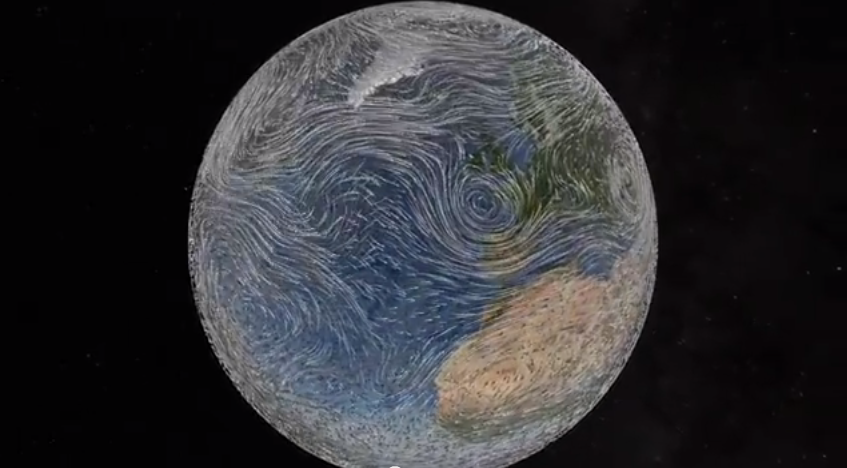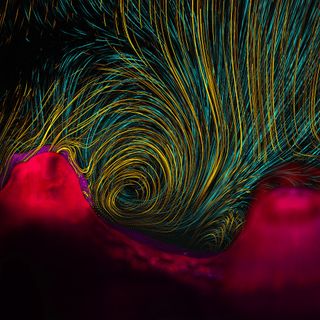Gorgeous Animation of Earth Takes Top Science Visual Prize

An animated film that reveals the beauty of the sun's interactions with Earth is one of the winners of an international contest in science visualization.
"Dynamic Earth" took first place in the video category of the 2013 International Science and Engineering Visualization Challenge. Other winners include a dreamy image of the miniscule micro-currents made by reef-building coral, and an eye-opening illustration of bacterial growth on the human hand.
"The winners made scientific data beautiful and brought their new ideas to life, while at the same time immersing the viewer in science," said Monica M. Bradford, executive editor of the journal Science, which sponsors the contest along with the National Science Foundation (NSF). [See Images of All the Visualization Winners]
Stunning photos and creative illustration
Contest judges choose winners in five categories: photography, video, games and apps, informational posters and illustration. This year's photography winners are Vicente Fernandez and colleagues at the Massachusetts Institute of Technology, who managed to capture a mini-whirlpool created by the beating cilia of cauliflower coral (Pocillopora damicornis). A micro-photograph of leaf hairs that look like tiny stars won honorable mention, as did another microscope-enabled shot of amazingly complex structures in a micropolymer.

The first-place winner of the illustration category was Greg Dunn, who created a work of art out of the layering of the brain's cortex. In Dunn's image, neural cells spread like tree branches on a leaf-green background. Illustrations that got honorable mentions include an actual "security blanket," a quilt printed with common passwords (including "password"). Another honorable mention illustration shows how microbes resist antibacterial soap with an image of bright-green bacterial colonies on the human hand.
The winners of the informational poster category, from Drexel University, created a sleek graphic to show how fabrics could be designed to store power. Honorable mentions went to posters explaining the physics of soap bubbles and the effects of cold water on sea turtles.
Sign up for the Live Science daily newsletter now
Get the world’s most fascinating discoveries delivered straight to your inbox.
Science screen time
In the gaming category, a game that lets players explore and map neurons took first prize. Three dimensional exploration was also the theme of one of the honorable mention honorees, which allows players to delve into Earth's deep past, watching it transform from melted lava ball to today's blue marble. The other honorable mention winner lets users explore the deep sea virtually.
The winner of the video category was an edited snippet from the planetarium show "Dynamic Earth," a 23-minute film narrated by actor Liam Neeson, now playing at 70 planetariums worldwide.
"We're very excited," said Greg Shirah, a science visualizer at NASA's Goddard Spaceflight Center in Maryland who worked on the visualization. The video combines three scientific models, one showing an ejection of solar particles from the sun, one showing those particles deflecting off Earth's magnetic shield, and one showing how the sun's heat drives the planet's winds. [See the Award-Winning Dynamic Earth Video]
"It was very challenging, especially taking all these different models that were run for different purposes and integrating them all together and making them fit together seamlessly," Shirah told Live Science.
Runners-up in the video category show how stem cells work, explore the human gut and visualize plant cells in three dimensions. The winners appear in the Feb. 7 issue of the journal Science.
Follow Stephanie Pappas on Twitter and Google+. Follow us @livescience, Facebook & Google+. Original article on Live Science.

Stephanie Pappas is a contributing writer for Live Science, covering topics ranging from geoscience to archaeology to the human brain and behavior. She was previously a senior writer for Live Science but is now a freelancer based in Denver, Colorado, and regularly contributes to Scientific American and The Monitor, the monthly magazine of the American Psychological Association. Stephanie received a bachelor's degree in psychology from the University of South Carolina and a graduate certificate in science communication from the University of California, Santa Cruz.










